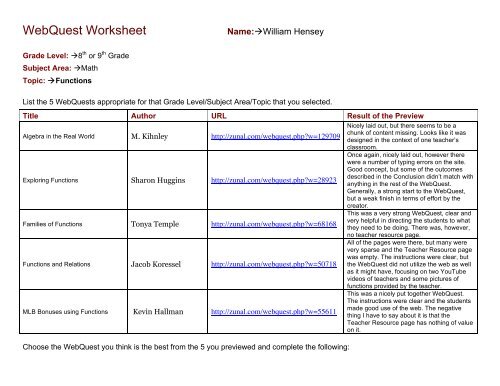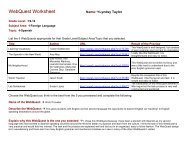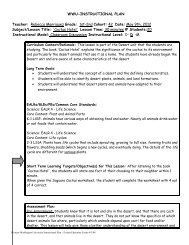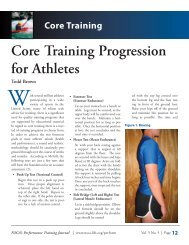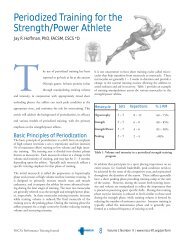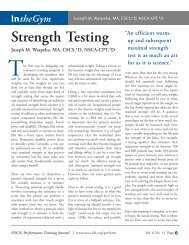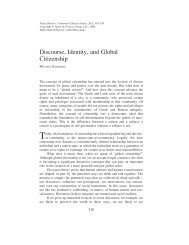WebQuest Worksheet
WebQuest Worksheet
WebQuest Worksheet
Create successful ePaper yourself
Turn your PDF publications into a flip-book with our unique Google optimized e-Paper software.
<strong>WebQuest</strong> <strong>Worksheet</strong><br />
Name:William Hensey<br />
Grade Level: 8 th or 9 th Grade<br />
Subject Area: Math<br />
Topic: Functions<br />
List the 5 <strong>WebQuest</strong>s appropriate for that Grade Level/Subject Area/Topic that you selected.<br />
Title Author URL Result of the Preview<br />
Algebra in the Real World M. Kihnley http://zunal.com/webquest.phpw=129709<br />
Exploring Functions Sharon Huggins http://zunal.com/webquest.phpw=28923<br />
Families of Functions Tonya Temple http://zunal.com/webquest.phpw=68168<br />
Functions and Relations Jacob Koressel http://zunal.com/webquest.phpw=50718<br />
MLB Bonuses using Functions Kevin Hallman http://zunal.com/webquest.phpw=55611<br />
Choose the <strong>WebQuest</strong> you think is the best from the 5 you previewed and complete the following:<br />
Nicely laid out, but there seems to be a<br />
chunk of content missing. Looks like it was<br />
designed in the context of one teacher’s<br />
classroom.<br />
Once again, nicely laid out, however there<br />
were a number of typing errors on the site.<br />
Good concept, but some of the outcomes<br />
described in the Conclusion didn’t match with<br />
anything in the rest of the <strong>WebQuest</strong>.<br />
Generally, a strong start to the <strong>WebQuest</strong>,<br />
but a weak finish in terms of effort by the<br />
creator.<br />
This was a very strong <strong>WebQuest</strong>, clear and<br />
very helpful in directing the students to what<br />
they need to be doing. There was, however,<br />
no teacher resource page.<br />
All of the pages were there, but many were<br />
very sparse and the Teacher Resource page<br />
was empty. The instructions were clear, but<br />
the <strong>WebQuest</strong> did not utilize the web as well<br />
as it might have, focusing on two YouTube<br />
videos of teachers and some pictures of<br />
functions provided by the teacher.<br />
This was a nicely put together <strong>WebQuest</strong>.<br />
The instructions were clear and the students<br />
made good use of the web. The negative<br />
thing I have to say about it is that the<br />
Teacher Resource page has nothing of value<br />
on it.
Name of the <strong>WebQuest</strong>: MLB Bonuses using Functions<br />
Describe the <strong>WebQuest</strong>: This <strong>WebQuest</strong> has students exploring some different families of functions and then using them to solve a baseball<br />
economics-related project. Students are divided into groups of two and are set on a task in which they choose 9 different baseball teams and develop functions to<br />
model bonuses for players on the different teams. At the end of the <strong>WebQuest</strong>, groups will create a PowerPoint, brochure, or poster to present both the functions<br />
that were created (outlining the process of creating the functions) and the bonus results for each team. The task involves the use of composite functions, inverse<br />
functions, linear and quadratic functions.<br />
Explain why this <strong>WebQuest</strong> is the one you selected: It was a very close choice between “Families of Functions” and “MLB Bonuses using<br />
Functions” which were by far the best of the bunch. I choose “MLB Bonuses” because it has the most clear and detailed instructions for the students of the two. I<br />
also thought that the theme might get some students excited about the project that usually may not be excited about math.<br />
Complete the <strong>WebQuest</strong> Evaluation Form<br />
<strong>WebQuest</strong> Evaluation Form<br />
Category Proficient Score Explanation<br />
Visual Appeal<br />
Mechanics<br />
Use of graphics enhances project;<br />
background makes visual connections to<br />
project; Color and font choice of text<br />
contributes to appeal and readability.<br />
There are no misspellings, grammatical<br />
errors, or missing project links.<br />
4 / 5 The pictures throughout the <strong>WebQuest</strong> all connect to the baseball<br />
theme and help keep subject coherence from page to page. There<br />
was one exception to this and that was the picture on the<br />
Introduction page. I find that this picture detracts from the project and<br />
may make students not take the quest very seriously.<br />
5 / 5 I did not find any grammatical or spelling errors and all of the links<br />
mentioned are there and still work.<br />
Credits<br />
All clip art, pictures, and content, if<br />
appropriate, are given credit.<br />
0 / 4<br />
None of the pictures are given credit and it is obvious that most of<br />
them are not the creators property.<br />
Content<br />
Includes all parts of a <strong>WebQuest</strong> including the Title, Introduction, Task, Resources, Process, Evaluation, and Conclusion pages.<br />
• Title<br />
Title reflects content of the <strong>WebQuest</strong> with<br />
appropriate page layout<br />
2 / 2<br />
It would be nice if the Title page as a little more descriptive, but I<br />
think it got the general idea across.<br />
• Introduction<br />
• Task<br />
The Introduction sets the stage and<br />
provides some background information.<br />
Task is engaging and asks for thinking<br />
beyond rote comprehension and<br />
knowledge acquisition. Students are<br />
required to synthesize and apply<br />
information from multiple sources to make<br />
2 / 2 It does this very well, highlighting the baseball theme as well as what<br />
students will see and learn by the end of the <strong>WebQuest</strong>.<br />
2 / 2 Students are asked to use key ideas about functions to solve a real<br />
world baseball economics problem. They will need to use synthesis<br />
in order to use the ideas about functions to solve the problem. In<br />
short, I think that will get students to think beyond the by-rote<br />
thinking.
a creative product.<br />
• Process<br />
The Process for completing the Task are<br />
clearly defined and lead to successful<br />
completion of the task. Students are not<br />
given so much detail that they have no<br />
room for individuality.<br />
3 / 3<br />
The Process for the task is described very well and lets students<br />
know what they need to do. At the same time, the process outlines<br />
places where students have to opportunity to make some choices<br />
about what they will be working with and doing for some parts of the<br />
quest.<br />
• Resources<br />
Resources were age-appropriate & varied.<br />
Resources were clearly connected to the<br />
information needed for students to<br />
accomplish the task.<br />
2 / 3<br />
Resources mostly came from different parts of two key websites. The<br />
sites are appropriate for the age-group but they do not provide a lot<br />
of variety for students.<br />
• Evaluation<br />
• Conclusion<br />
Teacher Page<br />
Criteria for student success are clearly<br />
stated in the form of a rubric. The<br />
assessment is aligned with the essential<br />
questions and the <strong>WebQuest</strong> task.<br />
The conclusion brings closure to the quest,<br />
reminds the learners about what they have<br />
learned, and perhaps encourages them to<br />
go further on their own.<br />
The teacher page includes information to<br />
help other teachers implement the<br />
<strong>WebQuest</strong> (e.g., target learners, standards,<br />
notes for teaching the unit, and, in some<br />
cases, examples of student work).<br />
2 / 3 The wording of some of the criteria in the rubric can be a little vague<br />
at times. However, in other places, the rubric is super-specific. So, in<br />
general, the rubric feels a little all over the map in specific<br />
expectations. The general evaluation ideas were pretty sound<br />
though and the assessment does align well with the <strong>WebQuest</strong> task.<br />
1 / 2 It does bring closure, but does not remind students about what they<br />
just did or encourage them to explore more on their own.<br />
0 / 4 The Teacher Page is used as a “Thank-you” from the author for<br />
looking at his <strong>WebQuest</strong> and provides no additional materials for<br />
teachers.<br />
Total 23 / 35


